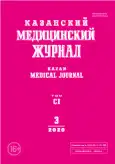Особенности резистентности к антибиотикам штаммов Staphylococcus aureus, выделенных при внутрибольничных инфекциях
- Авторы: Атакишизаде С.А.1
-
Учреждения:
- Азербайджанский медицинский университет
- Выпуск: Том 101, № 3 (2020)
- Страницы: 325-329
- Тип: Теоретическая и клиническая медицина
- URL: https://journals.rcsi.science/kazanmedj/article/view/34616
- DOI: https://doi.org/10.17816/KMJ2020-325
- ID: 34616
Цитировать
Аннотация
Цель. Изучение особенностей устойчивости к антибиотикам штаммов S. aureus, выделенных при внутрибольничных инфекциях (пневмонии, инфекции области хирургического вмешательства и сепсисе) в многопрофильной хирургической клинике.
Методы. Было проведено микробиологическое исследование мокроты 41 пациента с симптомами пневмонии, материалов (содержимого раны, дренажа и абсцесса), полученных от 40 больных с инфекциями области хирургического вмешательства, крови 46 пациентов с признаками сепсиса. Полученные культуры были идентифицированы общепринятыми методами (включая морфологические, культуральные, биохимические и т.д.). Чувствительность к метициллину определяли методом диск-диффузии, выявляя штаммы S. aureus, устойчивые к метициллину. Индуцибельную резистентность к клиндамицину у штаммов S. aureus определяли фенотипическим тестом (D-тестом).
Результаты. Среди штаммов S. aureus метициллин-резистентные обнаружены в 14,3% случаев (в 2 из 14) при инфекциях области хирургического вмешательства, в 27,3% (в 3 из 11) образцов мокроты пациентов с признаками пневмонии и в 50,0% случаев (в 7 из 14) при исследовании крови пациентов с сепсисом. Частота индуцибельной резистентности к клиндамицину у выделенных штаммов S. aureus при инфекциях области хирургического вмешательства (2 из 14 случаев, 14,3%) и пневмонии (2 из 11 случаев, 18,2%) мало отличалась от частоты устойчивости к метициллину (p >0,05), а при септических инфекциях была ниже — 7,1% против 50,0% (p=0,0328).
Вывод. Среди штаммов S. aureus, выделенных при внутрибольничных инфекциях, частота метициллин-резистентных штаммов не зависит от клинической формы госпитальной инфекции; а частота индуцибельной резистентности к клиндамицину при септических инфекциях ниже, чем устойчивости к метициллину.
Полный текст
Открыть статью на сайте журналаОб авторах
Садраддин Абдулла оглы Атакишизаде
Азербайджанский медицинский университет
Автор, ответственный за переписку.
Email: satakisizade@gmail.com
Азербайджан, г. Баку, Азербайджан
Список литературы
- Kang J., Sickbert-Bennett E.E., Brown V.M. et al. Relative frequency of health care-associated pathogens by infection site at a university hospital from 1980 to 2008. Am. J. Infect. Control. 2012; 40 (5): 416–420. doi: 10.1016/j.ajic.2011.06.013.
- Li J., Yu L., Yang J. et al. Species distribution of pathogens and prognostic factors for catheter-related bloodstream infections in intensive care unit. Zhonghua Yi Xue Za Zhi. 2015; 95 (9): 659–662. PMID: 25976045.
- Shahane V., Bhawal S., Lele U. Surgical site infections: A one year prospective study in a tertiary care center. Int. J. Health Sci. 2012; 6 (1): 79–84. doi: 10.12816/0005976.
- Gould I.M., Reilly J., Bunyan D., Walker A. Costs of healthcare-associated methicillin-resistant Staphylococcus aureus and its control. Clin. Microbiol. Infect. 2010; 16 (12): 1721–1728. doi: 10.1111/j.1469-0691.2010.03365.x.
- Priya Datta, Neelam Gulati, Nidhi Singla et al. Evaluation of various methods for the detection of meticillin-resistant Staphylococcus aureus strains and susceptibility patterns. J. Med. Microbiol. 2011; 60: 1613–1616. doi: 10.1099/jmm.0.032219-0.
- Prabhu K., Rao S., Rao V. Inducible clindamycin resistance in Staphylococcus aureus isolated fromclinical samples. J. Lab. Phys. 2011; 3 (1): 25–27. doi: 10.4103/0974-2727.78558.
- Lewis J.S., Jorgensen J.H. Inducible clindamycin resistance in staphylococci: Should clinicians and microbiologists be concerned? Oxford J. M. Health Clin. Infect. Dis. 2006; 40 (2): 280–285. doi: 10.1086/426894.
- Гублер Е.В. Вычислительные методы анализа и распознавания патологических процессов. Ленинград: Медицина. 1978; 296 с.
- Si D., Rajmokan M., Lakhan P. et al. Surgical site infections following coronary artery bypass graft procedures: 10 years of surveillance data. BMC Infect. Dis. 2014; 14: 318. doi: 10.1186/1471-2334-14-318.
- Takesue Y., Watanabe A., Hanaki H. et al. Nationwide surveillance of antimicrobial susceptibility patterns of pathogens isolated from surgical site infections (SSI) in Japan. J. Infect. Chemother. 2012; 18 (6): 816–826. doi: 10.1007/s10156-012-0509-1.
- De Kraker M.E., Jarlier V., Monen J.C. et al. The changing epidemiology of bacteraemias in Europe: trends from the European Antimicrobial Resistance Surveillance System. Clin. Microbiol. Infect. 2013; 19 (9): 860–868. doi: 10.1111/1469-0691.12028.
- Kavitha Prabhu, Sunil Rao, Venkatakrishna Rao. Inducible clindamycin resistance in Staphylococcus aureus isolated from clinical samples. J. Lab. Physicians. 2011; 3 (1): 25–27. doi: 10.4103/0974-2727.78558.
- Patel M., Waites K.B., Moser S.A. Prevalence of inducible clindamycin resistance among community and hospital-associated Staphylococcus aureus isolates. J. Clin. Microbiol. 2006; 44 (7): 2481–2484. doi: 10.1128/JCM.02582-05.
Дополнительные файлы






